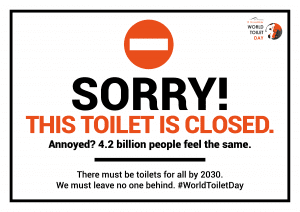Living in Australia, it is so easy to take going to a clean, safe toilet for granted. It is not something we recognize as a privilege. But did you know 4.2 billion people worldwide live without access to safely managed sanitation systems? Not million – BILLION.
Unsafe sanitation leads to the surrounding environments being contaminated by fecal matter. This contamination is the leading cause of diarrhea which, according to the UN, kills more than 800,000 children under the age of 5 every year.
The UN’s goal is to have safe sanitation and water for all by 2030. We can all do our part to raise awareness for this important step in ensuring no one is left behind. #worldtoiletday
What have toilets got to do with climate change?
• The effects of climate change threaten water, sanitation and hygiene (WASH) infrastructure, such as when floodwater contaminates wells used for drinking water or when flooding damages toilets and spreads human waste into communities and food crops. These incidents, which are becoming more frequent as climate change worsens, spread human waste into people’s living environments and cause deadly and chronic diseases. Sustainable sanitation means a system of reliable, effective fecal capture, disposal, treatment, and safe reuse, which is resilient to external shocks such as flooding, water shortages, and sea level rise.
• Most water and sanitation services around the world are water and energy-intensive. The processes involved in collecting, treating, and delivering water, and capturing, transporting, and treating human waste result in greenhouse gas emissions. Increasing the efficiency of these systems, and reducing unnecessary water consumption and water loss means lower energy use and therefore lower emissions. Biogas from human waste can also be captured and used for greener energy generation.
• Globally, 80% of the wastewater generated by society flows back into the ecosystem without being treated or reused. Sustainable sanitation systems capture, transport, treat, dispose of, and safely reuse human waste. In addition to the profound impact on health and living conditions, safely-managed wastewater has massive potential as an affordable and sustainable source of energy, nutrients, and water that can mitigate climate risk in the agriculture and energy sectors.
• Improving the way we manage human waste is key to reducing the impact of poorly-treated wastewater. Sustainable Development Goal 6 (target 6.3) requires us by 2030 to “improve
water quality by reducing pollution, eliminating dumping and minimizing release of hazardous chemicals and materials, halving the amount of untreated wastewater and
substantially increasing recycling and safe reuse globally.” The achievement of this target is essential for healthy water environments and creating sustainable livelihoods.
How do toilets protect our health?
• Without safely managed, sustainable sanitation, people often have no choice but to use unreliable, inadequate toilets or practice open defecation. Even where toilets exist,
overflows and leaks from pipes and septic systems, and dumping or improper treatment, can mean untreated human waste gets out into the environment and spreads deadly and
chronic diseases such as cholera and intestinal worms.
• Sustainable sanitation systems, combined with the facilities and knowledge to practice good hygiene, are a strong defense against COVID-19 and future disease outbreaks. Hand hygiene
is a lifesaver – regularly handwashing with soap and water or with alcohol-based rub is one
of the most effective barriers to the spread of diseases.
• Improving access to sanitation and handwashing facilities in healthcare settings will reduce infection and mortality rates, particularly in maternal and child health. Hygienic, private
bathrooms with clean, running water, sinks, and soap will help women and girls manage menstruation safely and with dignity.
(Source: https://www.worldtoiletday.info/wp-content/uploads/sites/2/2020/10/WTD-2020-toolkit.pdf)
